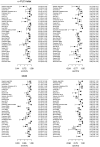Cerebrospinal fluid kappa free light chains for the diagnosis of multiple sclerosis: A systematic review and meta-analysis
- PMID: 36453167
- PMCID: PMC9925892
- DOI: 10.1177/13524585221134213
Cerebrospinal fluid kappa free light chains for the diagnosis of multiple sclerosis: A systematic review and meta-analysis
Abstract
Background: Intrathecal immunoglobulin-G synthesis is a hallmark of multiple sclerosis (MS), which can be detected by oligoclonal IgG bands (OCB) or by κ-free light chains (κ-FLC) in cerebrospinal fluid.
Objective: To perform a systematic review and meta-analysis to evaluate whether κ-FLC index has similar diagnostic value to identify patients with clinically isolated syndrome (CIS) or MS compared to OCB, and to determine κ-FLC index cut-off.
Methods: PubMed was searched for studies that assessed diagnostic sensitivity and specificity of κ-FLC index and OCB to discriminate CIS/MS patients from control subjects. Two reviewers following preferred reporting items for systematic reviews and meta-analyses (PRISMA) guidelines performed study eligibility assessment and data extraction. Findings from studies were analyzed with bivariate mixed models.
Results: A total of 32 studies were included in the meta-analysis to evaluate diagnostic value of κ-FLC index. Sensitivity and specificity ranged from 52% to 100% (weighted average: 88%) and 69% to 100% (89%) for κ-FLC index and from 37% to 100% (85%) and 74% to 100% (92%) for OCB. Mean difference of sensitivity and specificity between κ-FLC index and OCB was 2 and -4 percentage points. Diagnostic accuracy determined by mixed models revealed no significant difference between κ-FLC index and OCB. A discriminatory cut-off for κ-FLC index was determined at 6.1.
Conclusion: The findings indicate that κ-FLC index has similar diagnostic accuracy in MS as OCB.
Keywords: Cerebrospinal fluid; biomarker; clinically isolated syndrome; diagnosis; index; intrathecal fraction; kappa free light chains; meta-analysis; multiple sclerosis; systematic review.
Conflict of interest statement
Figures



References
-
- Stangel M, Fredrikson S, Meinl E, et al.. The utility of cerebrospinal fluid analysis in patients with multiple sclerosis. Nat Rev Neurol 2013; 9(5): 267–276. - PubMed
-
- Thompson AJ, Banwell BL, Barkhof F, et al.. Diagnosis of multiple sclerosis: 2017 revisions of the McDonald criteria. Lancet Neurol 2018; 17(2): 162–173. - PubMed
-
- Arrambide G, Tintore M, Espejo C, et al.. The value of oligoclonal bands in the multiple sclerosis diagnostic criteria. Brain 2018; 141(4): 1075–1084. - PubMed
-
- Freedman MS, Thompson EJ, Deisenhammer F, et al.. Recommended standard of cerebrospinal fluid analysis in the diagnosis of multiple sclerosis: A consensus statement. Arch Neurol 2005; 62(6): 865–870. - PubMed
Publication types
MeSH terms
Substances
LinkOut - more resources
Full Text Sources
Medical

